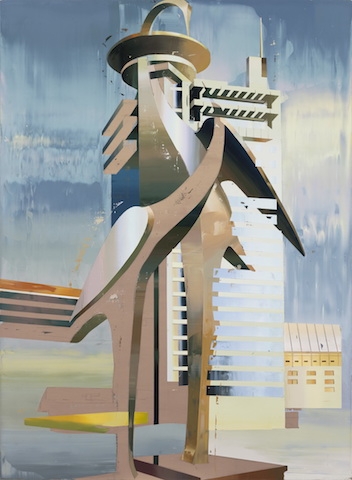The built environment of Chinese cities can provoke confusion: on the same block I encountered a golden-topped skyscraper adorned with blue windows in the style that dominated the Pearl River Delta during the 1990s, a former military warehouse from the Revolutionary era and a residential building embedded into a fake concrete mountain.
Cui Jie is best known for paintings, combining architectural fragments with dusty-pastel palettes, that build on her archival research into the stylistically diverse Chinese architecture and public sculpture of the period after the 1978 economic reform, as well as her interest in the Modernism of Le Corbusier and the Japanese architectural movement known as Metabolism. Her practice is less the painting of architecture than painting as architecture: stacked, repeated and dissected images of cityscapes are complicated by Cui’s painterly textures. For example, in the background of Zhao Wei Building (2014), huoshaoyun (literally ‘fire clouds’, a term used to describe orange-coloured clouds at sunset) are produced by painting meticulously along lines marked out in masking tape. Cui’s rethinking of spaces can be traced back to her earlier series Ground Invading Figures (2012–15), paintings of stock media images that accentuate the negative space between the human figures they contain. She also cites the montage techniques of Orson Welles as an inspiration for her practice of layering spaces onto a single, flat plane.
Some of the buildings in Cui’s architectural archive have been demolished, while many of the rest are facing demolition due to rapid reurbanisation. Although Cui paints ‘sinofuturist’ reconstructions of existing structures, she is not preparing memento mori or documentation. Instead she rearranges her experiences of spatial disorientation in Chinese urbanscapes and generates paintings from these ‘after-images’. A sense of physical disorientation is further represented by the lack of human figures (until her shared exhibition with Lee Kit at OCAT, Shenzhen, this year) in her paintings.
In Building of Cranes (2014), two towering birdlike structures based on a public sculpture in Dongguan are overlaid on a telecom building in Beijing. The buildings are painted from different perspectives, while the cold grey background eradicates the vanishing point of the composition. In Cui’s paintings, all the elements are arranged in such a way that they can be read independently of the whole, both breaking away from each other and combining to create new structures and alternative skylines.
Cui Jie lives and works in Shanghai. Her most recent solo exhibitions include The Enormous Space, OCAT Shenzhen (2018) and Latter, Former, Mother’s Tankstation, Dublin (2016). Cui will participate in the inaugural front International: Cleveland Triennial for Contemporary Art (2018)
Venus Lau is artistic director at K11 Art Foundation, Shanghai
From the Summer 2018 issue of ArtReview Asia, in association with K11 Art Foundation
